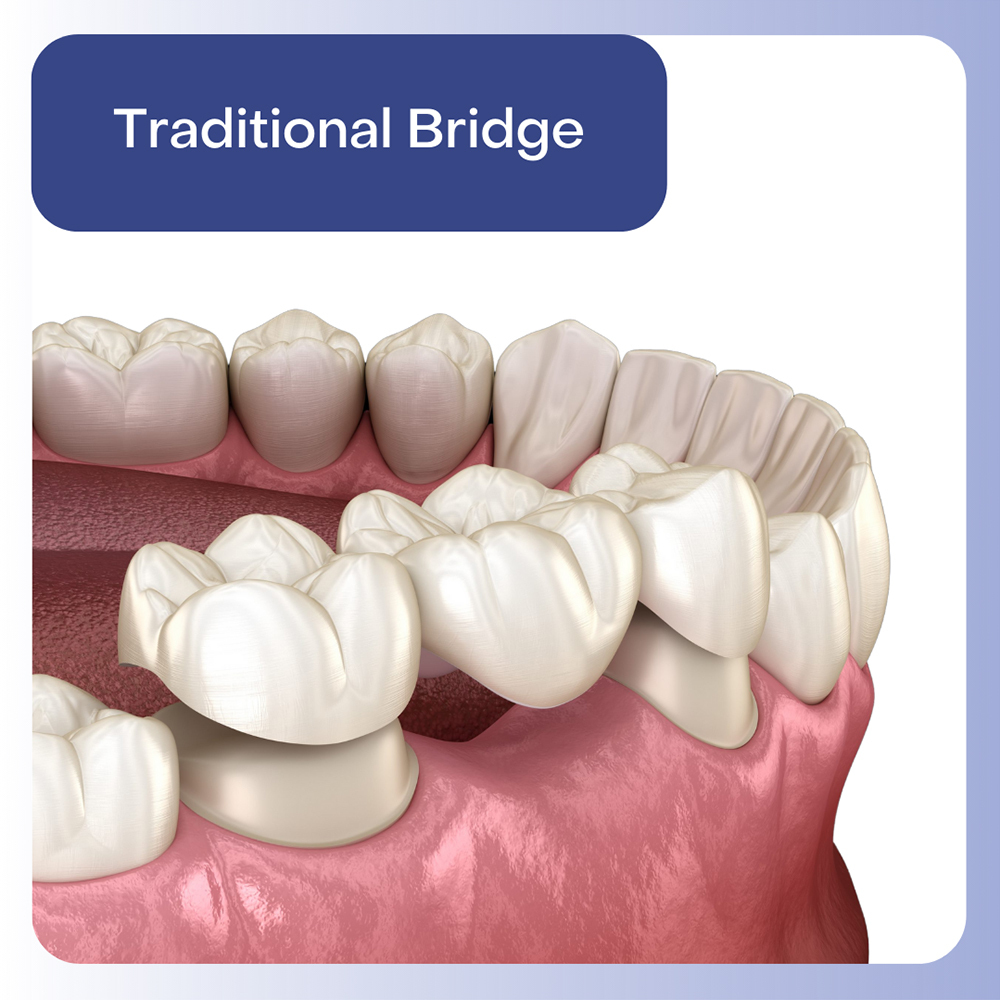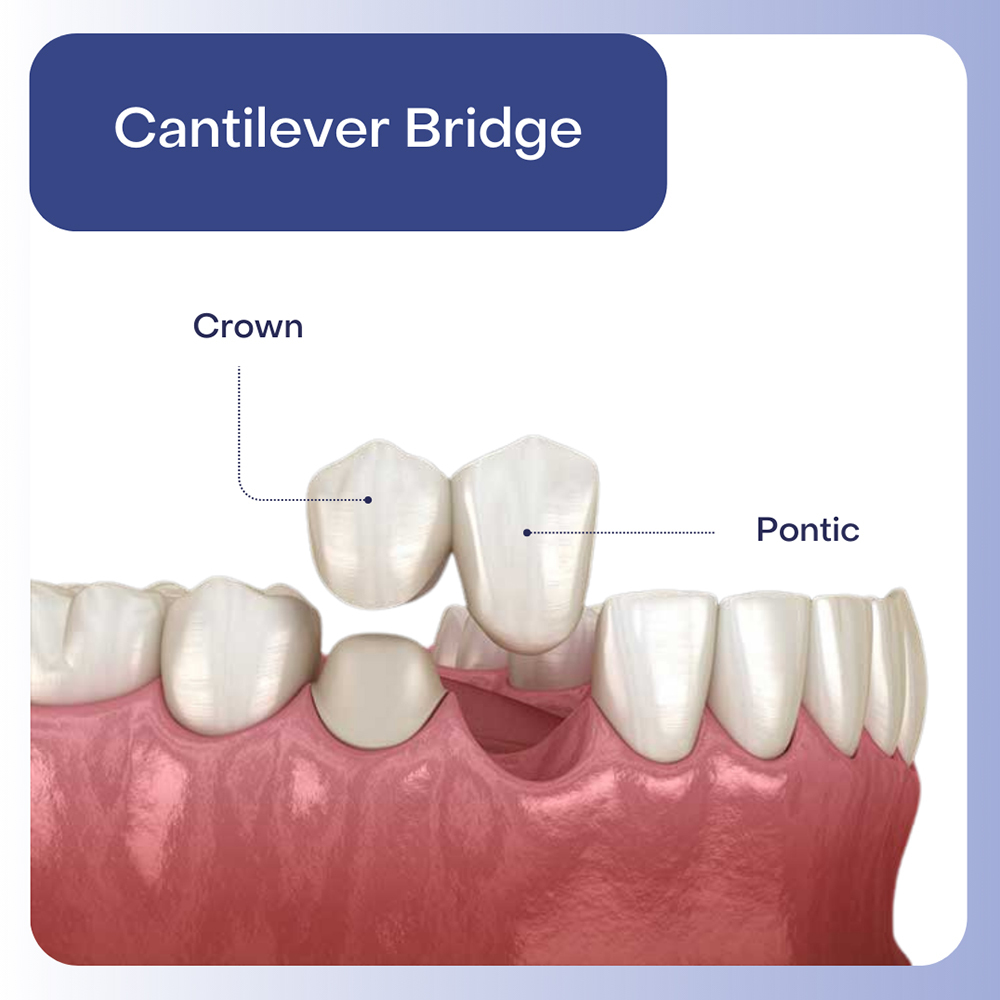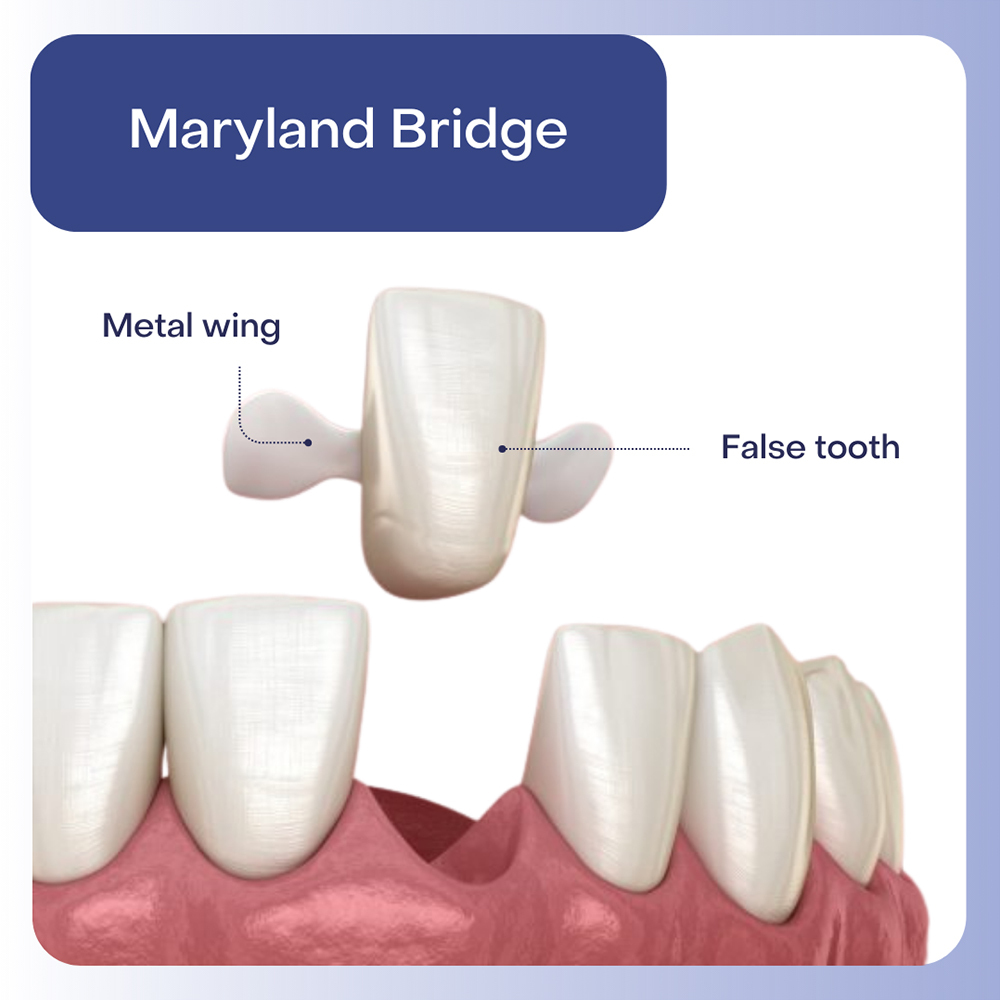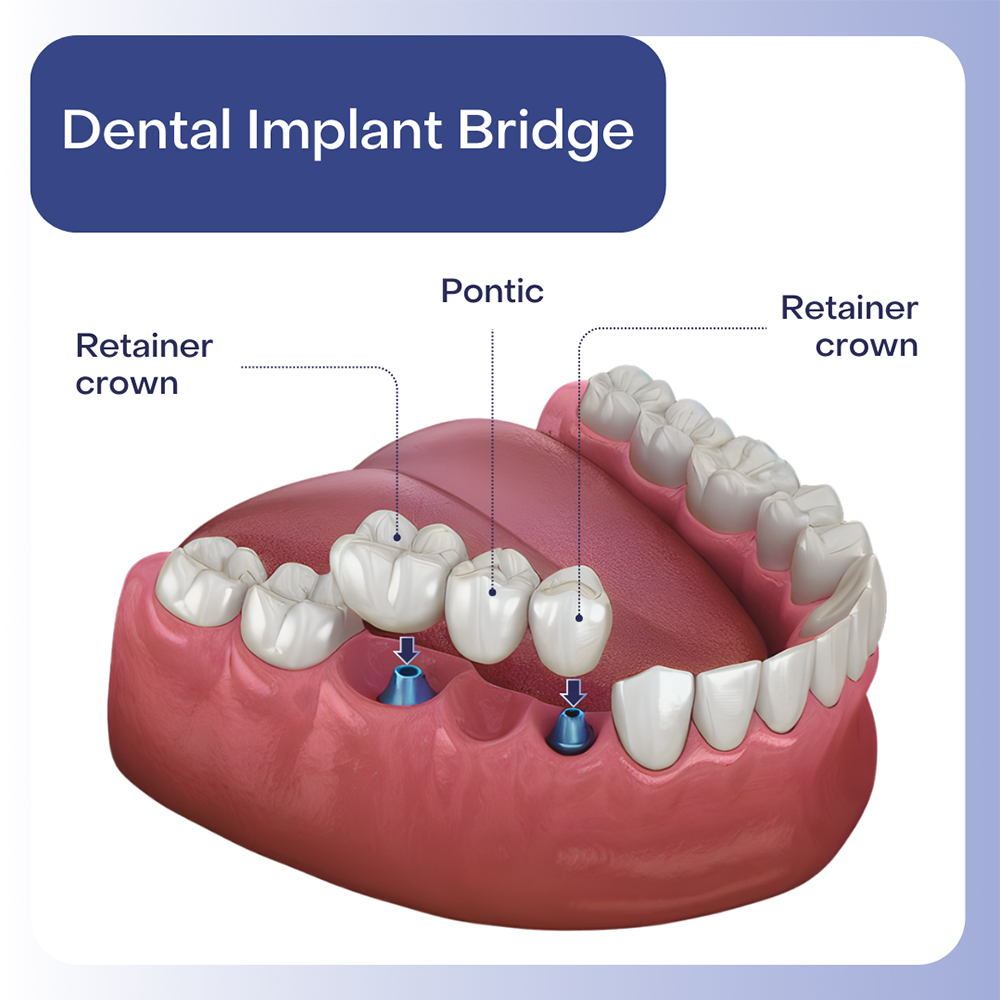Table of contents
When teeth are missing, a porcelain bridge can fill in the gap. Treatment is non-invasive, relatively quick to complete and provides a restoration that remains permanently in the mouth. Our on-site dental laboratory can fabricate custom dental bridges that look natural and feel comfortable, closely replicating real teeth.
If you are missing one or more teeth that were originally side-by-side, we may suggest replacing them with a porcelain bridge. There are several types available. All rely on abutment teeth that can support one or more replacement bridge teeth between them. Each bridge tooth is carefully contoured and rests directly on the gum.
Porcelain bridges can replace single or multiple missing teeth or even an entire arch.
Options include:
 Traditional dental bridges have abutment teeth on either side of the missing tooth. These abutment teeth are covered with dental porcelain crowns that cover the entire tooth, holding the replacement tooth, called a pontic, between them.
Traditional dental bridges have abutment teeth on either side of the missing tooth. These abutment teeth are covered with dental porcelain crowns that cover the entire tooth, holding the replacement tooth, called a pontic, between them.
The crowns are cemented over the abutment teeth, providing a stable restoration that fills in the gap created by one or more missing teeth.
 Sometimes, only abutment teeth are available on one side of the gap; in this case, a cantilever bridge might be suitable. A single dental crown attached to the pontic supports a cantilever bridge.
Sometimes, only abutment teeth are available on one side of the gap; in this case, a cantilever bridge might be suitable. A single dental crown attached to the pontic supports a cantilever bridge.
Occasionally, two teeth on one side support the replacement tooth or teeth. Covering an additional natural tooth with a crown helps provide extra strength and stability.
A cantilever bridge is less frequently used because of the stress placed on just one abutment tooth. Usually, a cantilever bridge is more suitable for replacing front teeth rather than back teeth that are subjected to greater chewing forces and where this type of bridge wouldn’t be strong enough.
 A Maryland or one-tooth bridge doesn’t rely on dental crowns for support. Instead, it has ‘wings’ that fit on the inner surfaces of the abutment teeth. These wings are virtually invisible once bonded onto the abutment teeth. Some wings have holes drilled into them, so the dental cement has greater adhesion.
A Maryland or one-tooth bridge doesn’t rely on dental crowns for support. Instead, it has ‘wings’ that fit on the inner surfaces of the abutment teeth. These wings are virtually invisible once bonded onto the abutment teeth. Some wings have holes drilled into them, so the dental cement has greater adhesion.
Maryland bridges are not very strong and tend only to be used to replace smaller front teeth, for example, the lower front incisors. The bond between the wings and the tooth can sometimes fail, so the bridge pops off and must be bonded back in place by a dentist.
 When abutment teeth are missing entirely, another option is to have an implant-supported bridge. Instead of relying on natural teeth for support, dental implants are inserted into the jawbone to anchor the bridge in place firmly.
When abutment teeth are missing entirely, another option is to have an implant-supported bridge. Instead of relying on natural teeth for support, dental implants are inserted into the jawbone to anchor the bridge in place firmly.
The bridge can be cemented onto the implants or, most likely, is screwed in position. Using screws to hold it in place allows us to retrieve the bridge more easily if required. The screw holes are covered with tooth-colored composite resin so they cannot be seen.
An implant-supported bridge can be a good option if you have multiple missing teeth or need to replace an entire arch. It is an alternative treatment to a full denture.
Read more: Dental Bridge vs Implants
Some people think that if they lose one or two teeth, they don’t need to replace them. Except for wisdom teeth, this isn’t the case. Losing teeth can impact you in several ways.
A well-designed dental bridge can address these issues, restoring your smile, self-confidence, and facial appearance. It is strong enough to allow you to eat whatever you wish, prevents unwanted tooth movements, and protects your bite.
Various porcelains can be used to make a bridge.
These include:
A PFM bridge is the most traditional. It has a thin metal substructure covered with porcelain to produce a lifelike appearance. PFM bridges are reasonably strong and durable and can be suitable for replacing back teeth. They are not ideal for replacing front teeth where aesthetics are more important. The metal substructure prevents light from passing through the restoration as with a natural tooth.
A pressable bridge made from a material like e.max produces beautiful results and is ideal when replacing front teeth. The material is reasonably strong and has a liveliness and natural translucency similar to real teeth. However, a pressable bridge is only really strong enough for a three-tooth or three-unit bridge. It is less suitable for restoring back teeth where greater strength is needed to cope with chewing food.
A zirconia bridge is extremely strong and can restore teeth anywhere in the mouth. There are various types of zirconia available. Some are more translucent and ideal when restoring front teeth. Another type is ideal for people with a very heavy bite or who have bruxism, where they clench and grind.
Zirconia is pre-shaded so it can be milled in the correct shape of the bridge, characterized, and polished. It can also be milled as a zirconia substructure that is then covered with more translucent porcelain to create a highly aesthetic effect.
Because zirconia is so strong, it can fabricate a bridge replacing multiple teeth. If you require a full arch bridge, it will be made from zirconia. We can also fabricate implant-supported bridges from zirconia.
It is hard to think of the disadvantage of choosing this restoration to restore missing teeth. However, it’s important to realize that our dentist will need to reshape the abutment teeth, removing enough tooth structure so they can be crowned without looking and feeling too big, bulky, and unnatural.
Removing healthy tooth structure is not ideal, although it can be a good option if these abutment teeth would benefit from the protection of dental crowns. If you have an implant-supported bridge, then this isn’t a problem.
A porcelain bridge should last years, and the material is stain-resistant. It is important to care for the bridge properly. You must clean underneath each pontic and around each abutment crown to thoroughly remove all plaque and food debris.
Regular preventive dentistry, including dental checkups and hygiene appointments, is vital so we can clean your bridge professionally. Regular hygiene appointments allow us to remove tartar buildup and check the bridge’s overall condition.
A dental bridge can normally be completed within a couple of weeks, with just two dental appointments needed.
Visit 1: After preparing your teeth using a local anesthetic, our dentist takes a detailed dental impression that is sent to our on-site dental laboratory. We select a shade of porcelain that will blend in with your natural teeth and liaise closely with our dental technicians to ensure your bridge is fabricated to our exact design.
While your bridge is being made, we can provide a temporary restoration until you return a couple of weeks later.
Visit 2: At your next appointment, we will remove the temporary bridge, try in your new bridge, and adjust if necessary before cementing it in place permanently.
If you choose an implant-supported bridge, then it will take longer. Dental implant treatment must be meticulously planned, and a short surgical procedure is needed to insert the implants into your jawbone. The implants need time to bond with the jawbone and may need to be left to heal undisturbed.
Sometimes, loading them with a new dental bridge soon after surgery is possible, but this may be a temporary bridge you wear while the implants heal. Once they are fused in your jawbone, your permanent implant bridge is fabricated and replaces the temporary restoration. The entire process can take several months to complete.
The cost will depend on the number of teeth that must be replaced, whether you have any failing teeth that must be removed first, and the material selected for your replacement bridge. Because this is a restorative dental treatment, dental insurance should cover at least part of treatment costs.
During your consultation, we can show you samples of each material so you can see how it might look in your mouth. We can provide a much clearer idea of the costs based on your chosen dental bridge and whether additional treatments are needed.
If you are missing one or more teeth or have teeth that are failing, a porcelain bridge can be a good option. There are many benefits in choosing this treatment, including cost and the time needed to complete the procedure. We only use the highest quality materials when fabricating dental bridges, ensuring you receive results that last longer and look better.
Your new bridge is customized to the exact specifications of your smile. Before cementing to the underlying teeth or affixing it to the supporting implants, the shade, occlusion, and all aspects of its fit get carefully checked. In addition to being designed to blend seamlessly with your smile, it’s also made to suit your bite and withstand all manner of oral function. We take great care to make sure your new restoration looks great, fits well, and that your bite feels comfortable.
Replacing missing teeth with a dental bridge is a worthwhile investment in the look, health, and function of your smile. While many dental insurances offer coverage for a dental bridge, and some toward the cost of implants, the benefits and amounts can vary significantly from plan to plan. At the office of My New Jersey Dentist, we understand the financial considerations involved in care and do all we can to help patients begin treatment without any additional stress or delay. In addition to doing our best to optimize your dental benefits, we also offer several payment and financing options. Feel free to contact our office if you have any questions on the cost of care, dental insurances, financing plans, or acceptable forms of payment.
Now that your new permanent crown or bridge is in place, it’s essential to maintain good oral hygiene. With proper care, your new restorations will last for years to come. Make sure to brush and floss as instructed. We’ll show you how to floss under your dental bridge to keep your new smile clean and bright. Remember to make appointments for your routine checkups and professional cleanings.
The standard answer is that with routine dental visits and good home care, a bridge can last ten to fifteen years, and in many cases, much longer.
At the office of My New Jersey Dentist, we fabricate your bridge from the highest quality dental materials to achieve the most cosmetically pleasing and lifelike results of care. It’s also customized to the exact specifications of your smile and designed for optimal aesthetics, strength, and stability. Once fabricated and cemented into place, you’ll feel confident sharing your smile, speaking, and eating your favorite foods.
As your trusted partner in care, we analyze every aspect of your smile to develop a treatment plan that provides aesthetically pleasing, healthy, and long-lasting results of care.
For more information on dental bridges, or any services we provide, give us a call today.

My name is Victoria Kushensky. I am a general dentist dedicated to remaining at the forefront of my field. Combining compassionate care with extensive knowledge, I offer cosmetic and general dentistry services as well as advanced root canal treatments.
I earned my Doctor of Dental Surgery (DDS) degree from the esteemed New York University College of Dentistry. Throughout my career, I have honed my skills in various dental procedures, ensuring effective treatment for each patient’s unique needs. I prioritize patient comfort and understanding, taking the time to thoroughly explain procedures and address any questions.
More about Dr. KushenskyMy NJ Dentist: Victoria Kushensky, DDS
385 Prospect Ave Suite 304
Hackensack, NJ 07601
(201) 298-8000